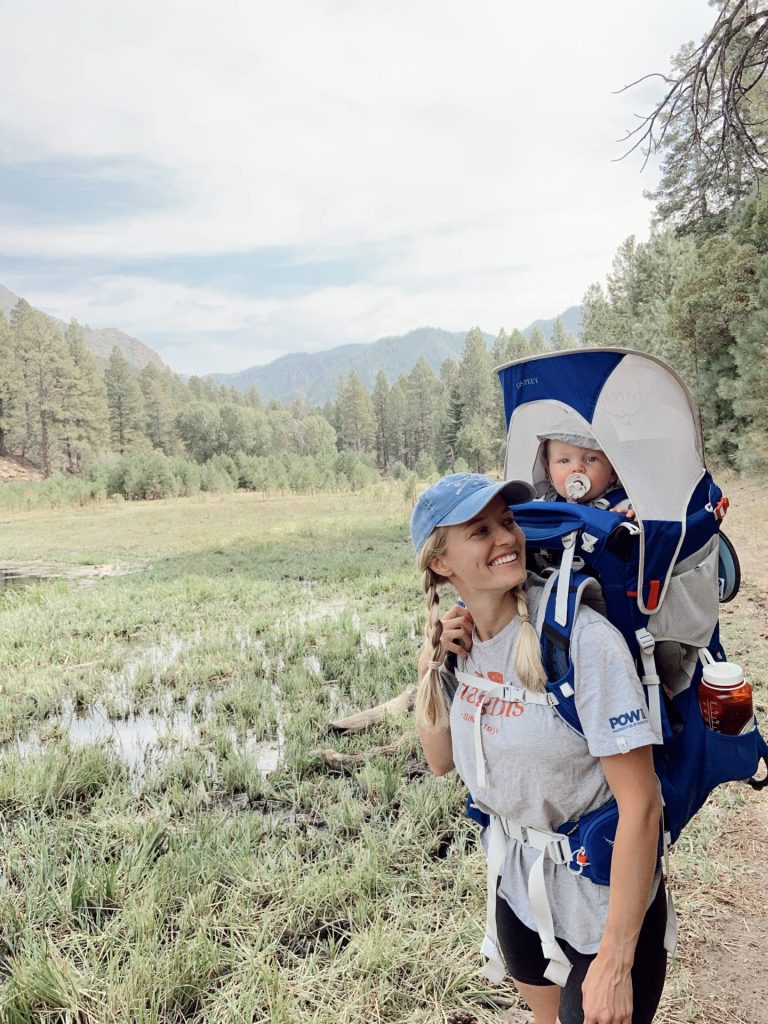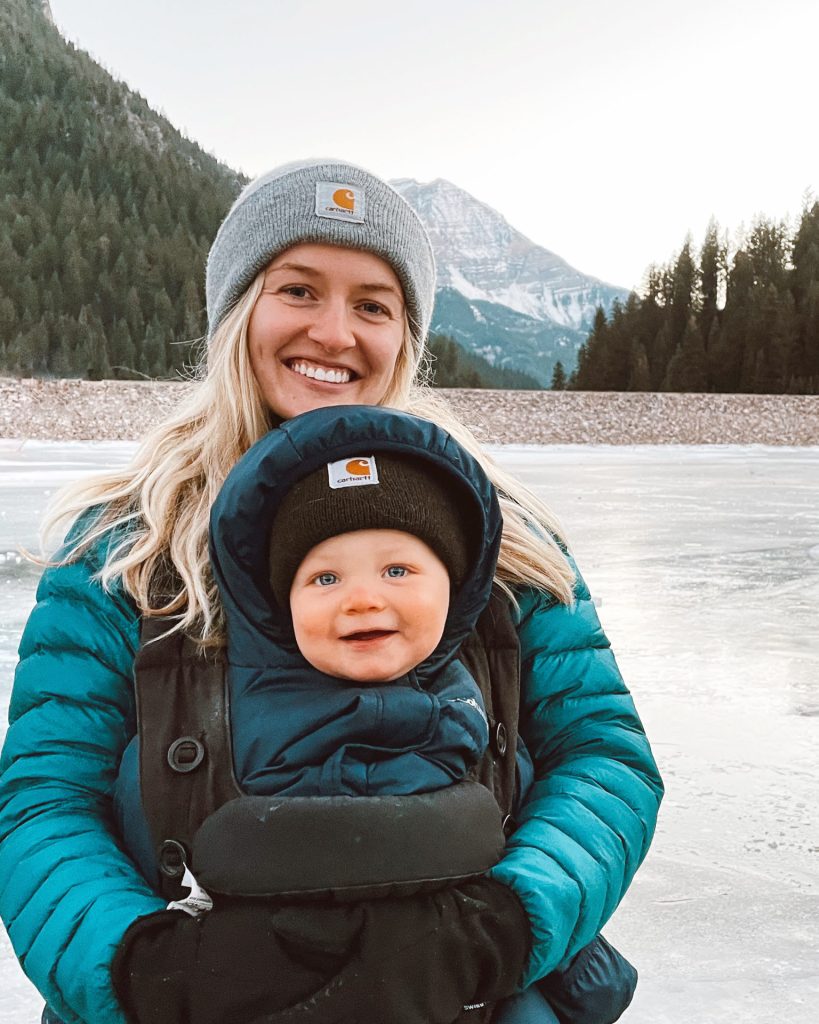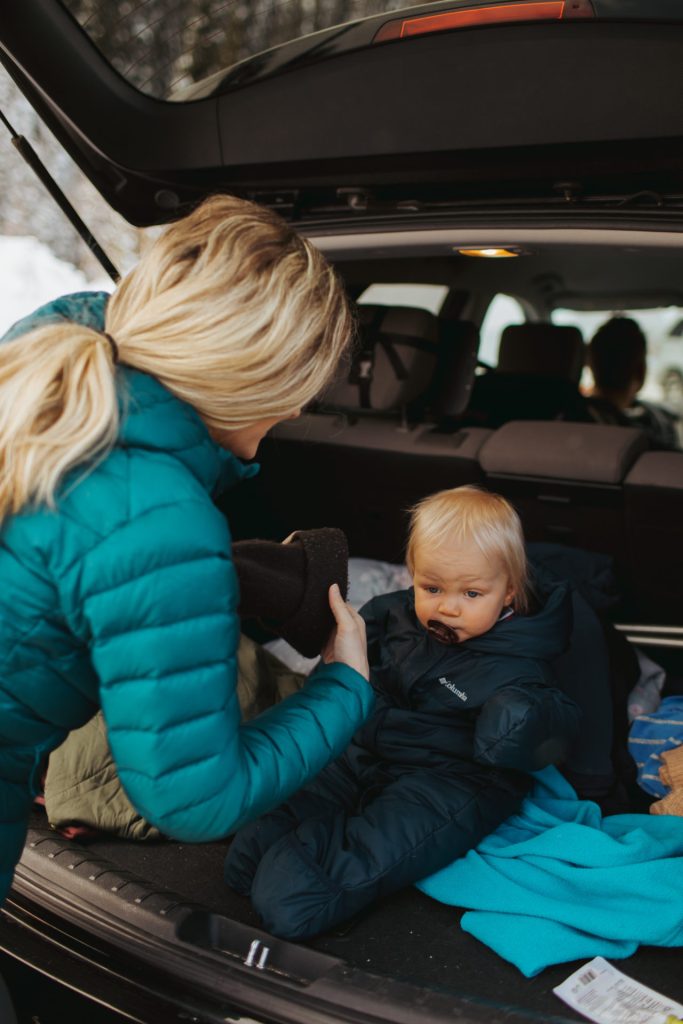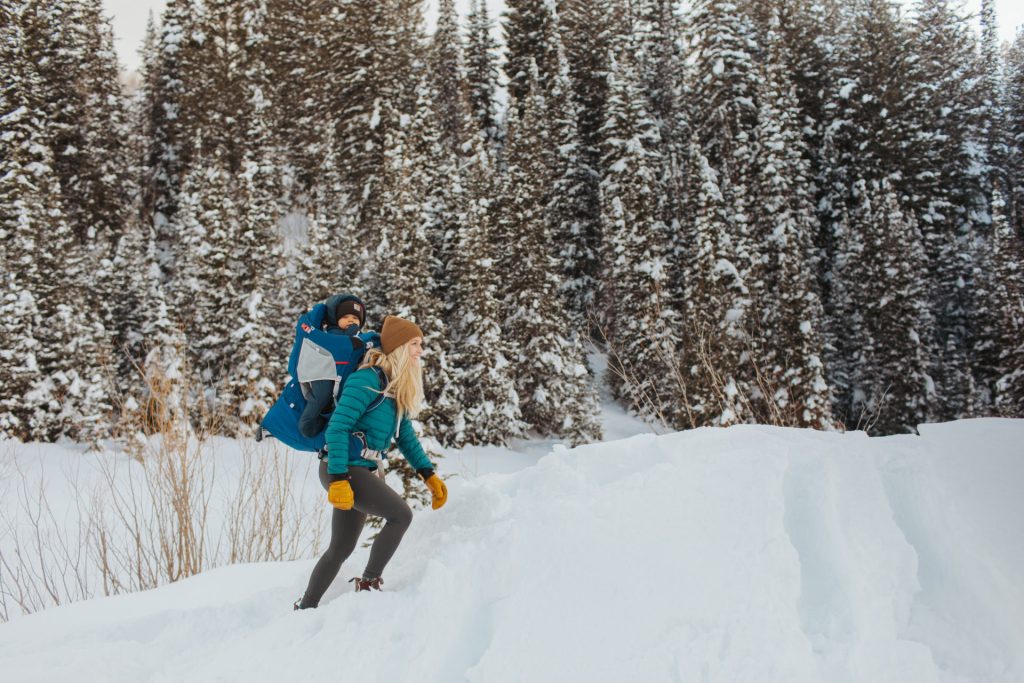By: Sarah Lamagna
You’ve stumbled upon a black bear hunting for some fresh berries before their annual hibernation and it sees you–what do you do? Climb a tree? Play dead? Principles of wildlife safety are not always common knowledge.
Despite what you’ve heard in stories and in the media, the correct way to interact with wildlife on the trail depends wholly on the species itself. The old sayings like “climb a tree, grizzlies won’t follow” or “play dead if a bear attacks” are largely misunderstood and, sometimes, simply incorrect.
As someone who spent most of their professional career working as a wildlife technician/ecologist, I have had my fair share of wildlife encounters. Although I don’t claim to know everything about the wildlife you might see on the trail, I am well-versed in the correct actions to take during such encounters.
When I became a parent, many friends and family members asked if I was scared on the trail when I hiked solo with my kid. They would specifically bring up the chance that we’d encounter some sort of terrifying wildlife. My response was always something along the lines of, “Nope, I know what to do plus my kid is so loud that any wildlife would likely run away.” In case, unlike me, you are nervous to get out on the trail with your kids due to the wildlife that call it home, I’m here to ease your minds. Getting outside with your kids is so important, and we should start when they’re young. Here is some general guidance of wildlife safety on the trails.
If you’d like more information on getting prepared for hiking with kids, check out my post on essential hiking gear for kids, or check out my backpacking gear list on Amazon for more ideas on how to stay safe and prepared on the trail
*The links shared in this post may be affiliate links meaning I make a small commission off of your purchase (with no extra cost to you). This allows me to continue to create free content for my readers. Thank you for your continued support!

How Close is Too Close?
Here is the general space you should give wildlife when you encounter them on the trails.
Bears (Grizzly and Black)
Coming across bears is probably one of the biggest fears people have when in the backcountry. Most of the time, bears will pay you no mind and saunter away in search of the food they truly enjoy (like fish and berries). But, you might encounter bears beefing up for hibernation or get between a mama and her cubs. In these cases, it’s helpful to know what to do.
Black Bears Have Fat Rumps
The first thing you need to figure out when you come across a bear and how to react to it, is what species it is. Because what you do when faced with a certain bear is dependent on what type it is. There are several ways to distinguish between black bears and grizzly bears.
- Look at the region you are in. Grizzly bears are found in western Canada, Alaska, Montana, Wyoming, Idaho, Washington, and, in rare cases, Colorado. Black bears, on the other hand, have a far wider range and are more likely to be seen on the trail.
- Don’t base your identification off of color. Grizzly bears can look very dark while black bears range from blonde to black.
- Look at their rumps. That’s right! Ogle those booties. Black bears have those big, wide rumps that are higher than their shoulders. Grizzly bears have a pronounced shoulder hump with a “dished” profile face (i.e., more concave). Grizzly bears also look a bit more disheveled than black bears who have, what I call, a “clean look.”
- Check out those ears. Grizzly bears have the more “teddy bear looking” ears that are short and rounded. Black bears have tall, pointed ears.
- Sometimes, size matters. Grizzly bears are, more often than not, significantly bigger than black bears.
When to Play Dead
I’m not certain who first coined this, but you don’t always play dead when faced with a bear. Again, it’s dependent on the species and what the signs are of whether they are going to charge and try to attack you.
In case of a grizzly bear encounter:
- Stay calm and do NOT make eye contact.
- Make sure your children are at your side. It’s always helpful to tell your children not to run too far ahead on the trail and to know prior what to do in case of an encounter.
- Do NOT drop your pack since this could be helpful in case of an attack. If you have a child carrier, take the kiddo out of it but then put the child carrier back on. Do this slowly.
- Start walking backward and slightly sideways (so you don’t trip) until you are safely out of the bear’s path.
- If the bear starts to walk toward you or bluff charges, stop moving and STAND YOUR GROUND. Make yourself as large as possible.
- Look for warning signs of an attack: ear lying flat and the head is held low.
- Do not climb trees. Although grizzly bears don’t tend to climb them often, they CAN climb trees despite what you might have heard.
- If it charges, wait until it’s 30 feet from you and use your bear spray. Keep your children behind you in case of blowback.
In case of a black bear encounter:
- Stay calm and calmly but strongly say hello. You can make eye contact.
- As with the grizzly encounter, keep your children close.
- Also like an encounter with a grizzly, start walking backward and to the side so you don’t trip and startle the bear.
- If the bear walks toward you, stop moving and stand your ground. Start yelling and throwing objects at it to get it to turn around.
- NEVER run and definitely DO NOT CLIMB TREES. Black bears have specific paws and claws that make them expert climbers.
In case of a grizzly bear attack:
- PLAY DEAD. No, seriously–play dead. Do what you’ve been told to do so often in the media.
- Lay flat on your stomach with your hands clasped behind your neck. This is where the pack comes in handy since the bears will have to go through your pack first.
- Spread your legs and make it hard for the grizzly to turn you over.
- Protect your kids and have them do the same thing as you.
- Only fight back if the attack intensifies (i.e., it literally starts to nibble/eat you)
- When fighting, go for the face and muzzles and keep fighting until you no longer can.
In case of a black bear attack:
- DO NOT play dead. Do the exact opposite of what you would do in a grizzly bear encounter.
- Use bear spray when they charge if you can (sometimes they might take you by surprise)
- FIGHT! Focus all your blows on the face and muzzle.
- Again, do not stop fighting for as long as you can. Kick, scream–do whatever you have to in order to get them off. Instruct your kids to do the same.
Mountain Lions
When I worked as a wildlife technician in Colorado, the first thing my supervisor told me before I went out into the field was, “If you see a mountain lion, it’s too late.” Maybe that wasn’t the best thing to say to a newbie field technician but it got the point across. Mountain lions are notorious for their silence and will likely catch you by surprise on the trail.
In case of a mountain lion encounter:
- Maintain eye contact.
- Pick up your children with as little bending down as possible. Again, maintain eye contact the whole time. Move older kiddos behind you.
- Stay calm–you can poop your pants later. Quickly explain to your kid what is going on.
- Back away slowly but DO NOT RUN or climb up a tree.
- Speak firmly and loudly. Really any words will do: “Please don’t eat me,” “I don’t like you,” or “My what big teeth you have.”
- If the mountain lion charges, act BIG. Use anything to act bigger including trekking poles, your child carrier, hands. Tell your kiddos to do the same.
- Then get the heck out of there once the mountain lion retracts. Do not dawdle!
In case of a mountain lion attack:
- Much like the black bear, fight back. Do NOT play dead.
- Kick, scream, and punch its face and muzzle. Do not stop fighting.
Moose
As someone who has spent three decades in the wilderness, the animal I am most scared of is the moose. Unlike bears and mountain lions, moose are very erratic in their behavior and can switch up their moods in an instant. When I know I am in moose habitat, I take extra care on the trail.
In case of a moose encounter:
- Stop and assess the area. How many moose are there? Are their calves present? Can I get around them safely?
- If you are sure you’ve spotted all the moose, give them a wide berth (at least 75 feet). If you cannot pass them with enough space, then turn around.
- If the moose changes its behavior in any way, turn around. When they change behavior it usually indicates that you are making them uncomfortable so you should leave the area before they make you.
- Look for warning signs of a charge.
In case of a moose attack:
- Look for warning signs of a charge:
- Laying their ears back
- Having the hair on the back of their neck or hips stand up
- Smacking their lips
- Showing the whites of their eyes
- Tossing their head
- Urinating on their back legs
- If they charge, RUN. Never stand your ground with a moose–they are way bigger than you and can easily trample you to death. Find the nearest tree to get behind and keep rotating as the moose tries to slam through the tree.
- Leave when the moose has decided to stop charging you.
Wolves and Coyotes
Chances are if you are hiking during the day, you won’t stumble upon a pack of wolves. Both wolves and coyotes are generally active during the early morning and late evening. They are known as “crepuscular” animals or ones that have peak activity at dawn, dusk, and during twilight hours. If you do encounter them during the day, there may be something slightly wrong with them (i.e., infected with rabies or some other illness) so steer clear!
In case of a wolf encounter/attack:
- Pick up your kids immediately. Move your older kiddos behind you.
- Maintain eye contact
- Stand tall and make yourself look bigger. If there is an incline anywhere around you, stand there to appear bigger.
- Stay calm and, as always, do NOT run. Slowly back away and maintain eye contact.
- If the wolf keeps approaching, still keep backing away and maintaining eye contact.
- If you have a dog with you, stand between your dog and the wolf–this usually ends the encounter. If the wolf attacks your dog, do NOT get in between the fight.
- Look for warning signs of an attack:
- Holding its tail high.
- Raising its hackles.
- Barking/howling aggressively.
- If any of these signs occur, yell and throw things at it.
- If you are attacked, fight back aggressively and aim for the muzzle and face.
In case of a coyote encounter/attack:
- Like with a wolf, pick your kids up immediately and get older kiddos to stand behind you.
- Maintain eye contact and stay calm.
- Do not turn your back on the coyote so back up slowly while maintaining eye contact.
- Act big and loud.
- Usually the instant you start to back away, the coyote leaves. If, however, they don’t immediately leave, you are likely near their den so they won’t ever be leaving. They protect their babies. So keep walking backwards until they stop approaching you.
- If you are attacked, fight back just like you would a wolf. Aim for the muzzle and face.
In Summary…
Obviously this isn’t an exhaustive list of all the types of animals you might encounter on the trail. I’ll argue that they are the most concerning of all the animals you might meet, though. The big takeaway I want you to have from reading this is to know that you are in THEIR territory. Act respectfully and with caution anytime you get outdoors and into the backcountry. The wildlife safety tips above won’t stop you from having an encounter but can help you when you find yourself in one.
However, I always like to add that your kid is likely the loudest thing on the trail and wildlife will hear them from a mile away. More than likely, you won’t have a chance encounter with any wild beasts since you have one of your own already singing “Let It Go” at the top of their lungs. Or, wait, is that just me?
If you found this post helpful, check out my other posts on safety and responsibility outdoors:





